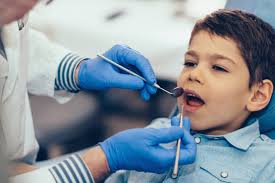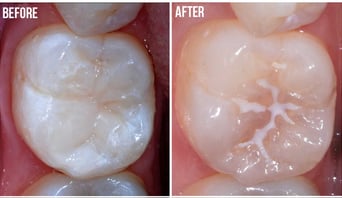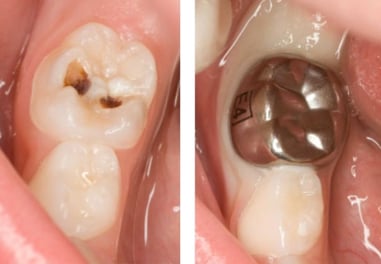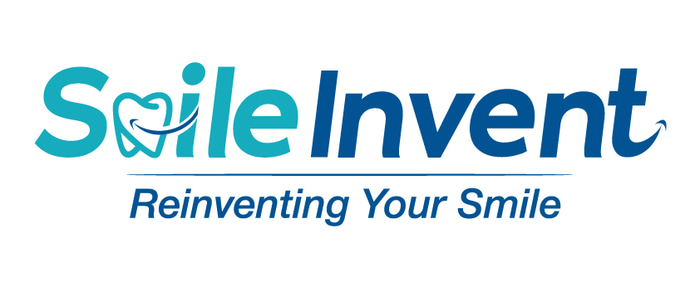Pediatric Dentistry
Child Dental Exam and Cleaning
A child dental exam and cleaning is an important preventive dental care visit to ensure good oral health and proper dental development. Here's what you can typically expect during such an appointment:
1. Dental Exam
Medical History Review: The dentist or hygienist reviews the child's medical and dental history.
Assessment of Teeth and Gums: The dentist checks for cavities, plaque, and tartar build-up, as well as the condition of the gums.
Evaluation of Dental Development: The dentist assesses the alignment of the teeth and jaw and monitors how the child’s teeth are growing.
X-rays (if necessary): X-rays may be taken to detect cavities or other issues not visible during the physical exam.


2. Dental Cleaning
Plaque and Tartar Removal: A hygienist or dentist uses special tools to clean away plaque and tartar, especially in hard-to-reach areas.
Polishing: The teeth are polished with a rotating brush and a flavored toothpaste to remove stains.
Flossing: The child’s teeth are flossed to ensure a thorough cleaning.
Fluoride Treatment (optional): A fluoride gel or varnish is applied to strengthen the teeth and prevent cavities.
3. Education and Guidance
Oral Hygiene Tips: Guidance on brushing, flossing, and maintaining healthy eating habits is provided.
Discussion with Parents: The dentist may discuss findings, potential concerns, and recommendations for follow-up care.
Sealants and Fluoride Treatments
Sealants and fluoride treatments are two preventive dental care options aimed at protecting teeth from decay and strengthening enamel. Here’s a breakdown of each:
Dental Sealants
Purpose: Prevent tooth decay by creating a protective barrier.
Material: Thin, white coating applied to the chewing surfaces of molars and premolars (where grooves and pits are prone to trapping food and bacteria).
Process:
1. Teeth are cleaned and dried.
2. An acid solution is applied to roughen the tooth surface for better adhesion.
3. Sealant is painted onto the tooth and hardened using a special light.


Ideal Candidates: Children (especially when permanent molars come in) and adults without decay or fillings in the treated teeth.
Lifespan: Can last several years with proper oral care.
Fluoride Treatments
Purpose: Strengthen tooth enamel and make it more resistant to decay.
Material: Highly concentrated fluoride (in gel, foam, or varnish form).
Process:
1. Teeth are cleaned before applying the fluoride.
2. The treatment is applied with a brush, tray, or rinse and left for a few minutes.
3. Patients are advised not to eat or drink for 30 minutes to allow proper absorption.
Ideal Candidates: Both children and adults, especially those at higher risk of cavities.
Frequency: Recommended every 6 months or as suggested by a dentist.
Key Differences
Both treatments are often used together as part of a comprehensive dental care plan for optimal protection against cavities.
Pediatric Fillings and Crowns
Pediatric fillings and crowns are dental treatments used to restore decayed or damaged teeth in children. Here's a detailed overview:
Pediatric Filling
A filling is used to repair minor to moderate tooth decay or damage.
When It's Needed:
Small to medium-sized cavities.
Minor chips or cracks in the tooth.
Procedure:
1. Assessment: Dentist examines the tooth using X-rays or a clinical exam.
2. Preparation:
The area is numbed with local anesthesia.
Decayed or damaged parts of the tooth are removed.
3. Filling Material:


Common materials include composite resin (tooth-colored) or amalgam (silver-colored).
Composite is often preferred for aesthetic reasons.
4. Placement: The filling material is applied, shaped, and hardened using a curing light.
Aftercare:
Encourage proper brushing and flossing to prevent further decay.
Avoid sticky or hard foods for a few hours post-treatment.
Pediatric Crown
A crown is a cap placed over a tooth to restore its shape, size, and function when the damage is too extensive for a filling. When It's Needed: Severe tooth decay affecting most of the tooth. Cracked or broken teeth. Teeth treated with a pulpotomy (baby root canal). Protection for teeth with developmental defects.
Types of Pediatric Crowns:
1. Stainless Steel Crowns (SSCs):
Durable and commonly used for baby teeth.
Cost-effective and quick to place.
2. Tooth-Colored Crowns:
Made from composite or ceramic for better aesthetics.
Used for front teeth or when appearance is important.
Procedure:
1. Preparation:
Decay is removed, and the tooth is reshaped.
For severe cases, a pulpotomy may be performed before placing the crown.
2. Fitting:
The crown is custom-fitted or pre-formed, then cemented onto the tooth.
Benefits of Crowns:
Protect the tooth from further decay or damage. Restore function and appearance.
Differences Between Fillings and Crowns
Both procedures are essential for maintaining oral health and preventing further complications, even in baby teeth, which play a crucial role in guiding permanent teeth into place.
